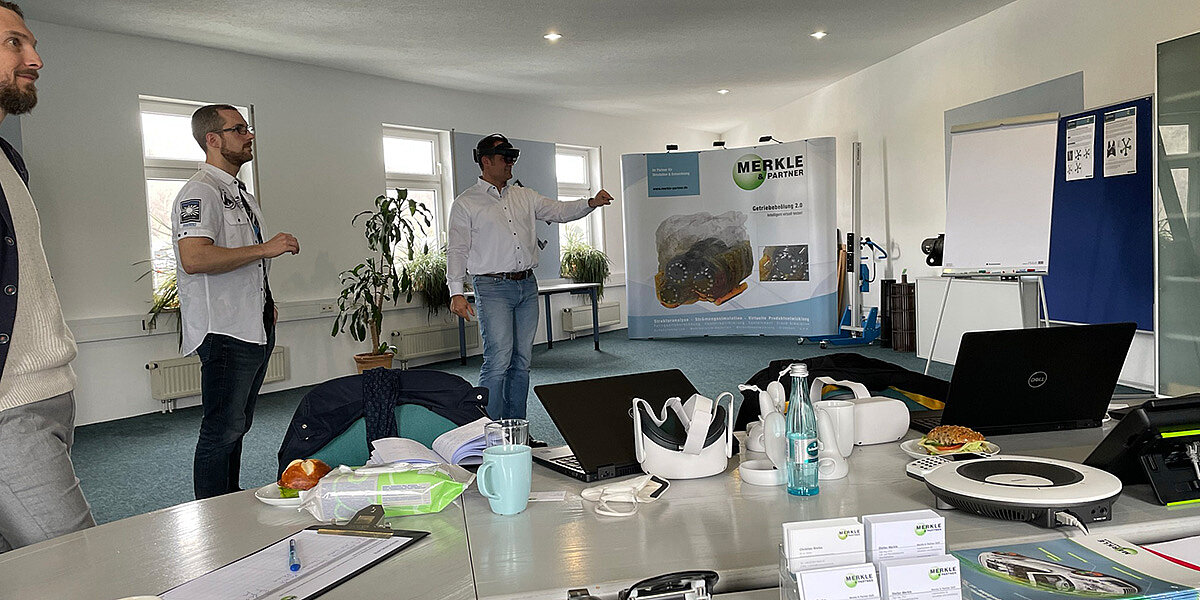Flow through rose colored glasses

Admittedly, the VR glasses with which we were able to view our flow results three-dimensionally were not pink, but rather somewhat clunky. The AR glasses were a bit more elegant, but not as colorful.
But one after the other:
On April 6th of this year (2022), we had a visit at Merkle CAE Solutions from Sebastian Kreibich and Thomas Schweiss, from the August-Wilhelm Scheer Institut für digitale Produkte und Prozesse GmbH from Saarbrücken, to show us the current state of VR and AR flow visualization with their own software developments.
With virtual reality (VR), you only see the virtual space, while with augmented reality (AR) you see the environment as before, but also receive digital data. You have visions, so to speak, without having to see a doctor right away.
The fundamental question for us as a CAE service provider is whether you, as a Merkle CAE Solutions customer, are prepared to pay the additional expense for virtual reality for your projects, i.e. whether you see a significant benefit for yourself here, or whether this is currently just a gimmick for you.
If you look around on the Internet for VR or AR glasses, there is a wide range of glasses from €515 for the Oculus Quest 2 to €3,849 for the Microsoft Hololens 2.
The investment costs are therefore in a realistic range, plus the as yet undetermined amount x for the monthly licenses of a platform solution, comparable to teams meetings, only with glasses and a virtual meeting room.
On such a virtual platform, we could meet to jointly discuss results and identify optimization opportunities of critical zones.
Especially in the field of fluid mechanics (CFD), this can be quite helpful for a better understanding of the physical processes and for the discussions with you, our customers. This will give you a deeper insight into the virtual worlds of CFD flow with Merkle CAE Solutions.
Of course, it is also possible to look at structural mechanics results from an FE calculation (FEA), although looking at a structure from the outside is more likely to be possible by conventional means than looking at a flow, which per se fills a three-dimensional space.
But all of this is still pie in the sky.
For a comfortable, technical discussion, however, the glasses are still too clunky at this stage and the virtual worlds are not yet spectacular enough to move results meetings into virtual rooms at the current time.
However, I think it is only a matter of time before this step will come. Especially if transient, dynamic results can also be displayed. A changing vortex looks better than rigid streamlines. Currently, the prototype can't do that yet, because the hardware would be overloaded.
The AR solution is currently still a bit pale. At least it allows better orientation, whereas the interaction leaves much to be desired in the pure VR solution. There is also a certain "vomit factor" when you spend too much time behind the glasses, isolated from the real world. But maybe that's just me.
In any case, it's a huge step forward for 3D visualization compared to the Cave we had the pleasure of presenting in 2014 at Merkle CAE Solutions' company anniversary.
However, it is still a long way to go to the starting stretch appearance à la Master Yoda as a hologram.
How do you see the development? Feel free to share your experiences with me and how you see future development.
We will definitely stay on the ball for you.
Yours Stefan Merkle

PS: If you would like to take a look behind the scenes beforehand at what else is possible without 3D glasses, take a look at our homepage
https://www.merkle-partner.de/service/3d
You can rotate the calculation examples and look at them from different perspectives.
Here could be, in a protected area, only for you accessible, your own project.
The texts in the description are not yet complete, but you get an impression of what is currently already possible.